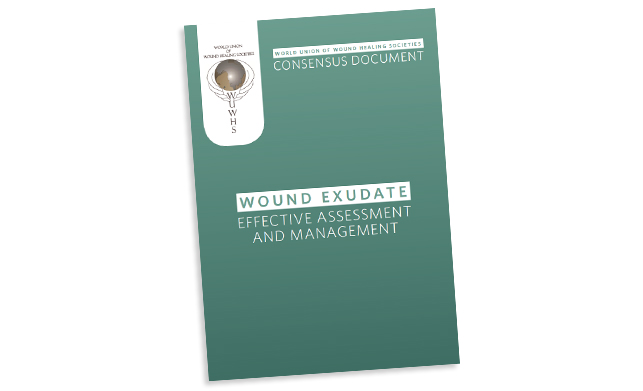New guidelines extend recommended solutions for more effective wound treatment
Consensus document includes use of superabsorbent polymer dressings in wound treatment for the first time
The new WUWHS consensus document “Wound Exudate: Effective Assessment and Management” pays specific attention to three key areas: the role of moisture balance in wound healing; exudate-related periwound skin problems and care; and the impact of exudate on patient quality of life. SAP dressings such as HARTMANN’s Zetuvit® Plus Silicone offer a number of benefits in all three areas.
The importance of moisture balance in wound healing
Wound exudate – often known as wound fluid or wound drainage – is produced as a natural and essential part of the healing process.2 However, excessive or insufficient exudate production, the wrong composition or exudate in the wrong place can have an adverse effect on wound healing.3 For assessing the amount of exudate being produced by a wound, WUWHS’s Expert Working Group favoured Falanga’s Wound Exudate Score4 because of its simplicity and three-level classification. Two of the three levels require absorptive dressings and for both of these Zetuvit® Plus Silicone can offer an effective solution for balancing the moisture level of the wound bed.
Alleviating exudate-related periwound skin problems
Excessive exudate production can lead to periwound skin damage through maceration and erosion. Prevention and treatment of maceration is important; unchecked it can lead to the wound expanding and can cause pain or discomfort. The consensus document states that dressings should prevent leakage and allow for extended wear in order to protect the wound and avoid exudate coming into contact with the periwound skin to assure optimal healing. Thanks to their superabsorbent qualities, SAP dressings effectively protect vulnerable periwound skin not only by absorbing excessive exudate that could otherwise leak to periwound skin but also potentially reducing the number of dressing changes necessary. To ensure an especially gentle removal for fragile periwound skin, SAP dressings with a silicone layer are available.
Improving patient quality of life
Excessive exudate can have a serious psychosocial impact on patients and reduce quality of life.5 Leakage through or from around the dressing is often a distressing situation for patients in both their work and social lives: the need to change dressings can be a major disruption and the fear and potential embarrassment related to leakage or odour can prevent patients from leaving their homes. SAP dressings can reduce the risk of leakage thanks to their high level of absorption and sequester odour, thereby reducing the level of the stress and social isolation that patients with moderate to high exuding wounds experience, offering them a more comfortable treatment and better quality of life.

About the HARTMANN GROUP
The HARTMANN GROUP is one of the leading providers of medical and hygiene products with its core expertise being in wound treatment (e.g. wound dressings, negative pressure wound therapy, conforming bandages and adhesive plasters), incontinence care (e.g. single-use incontinence pants and pads as well as skincare products for use in case of incontinence) and infection prevention (e.g. surgical custom procedure trays, surgical gowns, single-use surgical instruments and disinfectants). Its range also includes products for compression therapy and First Aid in addition to care products and cosmetics. Furthermore, HARTMANN offers innovative system solutions for professional target groups in the medical and healthcare sector. The Company, which has its headquarters inHeidenheim and which has Europe as its focal market, is organized with its own country companies close to the markets across the world. In 2018, the 11,027 employees of the HARTMANN GROUP generated sales of €2.12 billion.
PAUL HARTMANN AG, which is based in Heidenheim, Germany, forms the heart of the corporate group. It is one of Germany's oldest industrial companies, having been originally founded as a textile factory by Ludwig von Hartmann in 1818. In 1873, the latter's son Paul Hartmann, began production of absorbent cotton wool, and later the Company evolved into the flagship of an expanding dressing materials industry worldwide. The HARTMANN GROUP encompasses not only numerous sales companies abroad but also, among others, BODEChemie (Hamburg), KNEIPP (Würzburg), Karl Otto Braun (Wolfstein), andSanimed (Ibbenbüren).
References. 1 World Union of Wound Healing Societies (WUWHS) Consensus Document. Wound exudate: effective assessment and management Wounds International, 2019.
2 Lloyd Jones M (2014) Exudate: friend or foe? Br J Community Nurs (Suppl): S18–23.
3 Moore Z, Strapp H (2015) Managing the problem of excess exudate. Br J Nurs 24(15): S12–7.
4 Falanga V (2000) Classifications for wound bed preparation and stimulation of chronic wounds. Wound Rep Reg 8(5): 347–52.
5 Benbow M, Stevens J (2010) Exudate, infection and patient quality of life. Br J Nurs 19(20): S30–6
